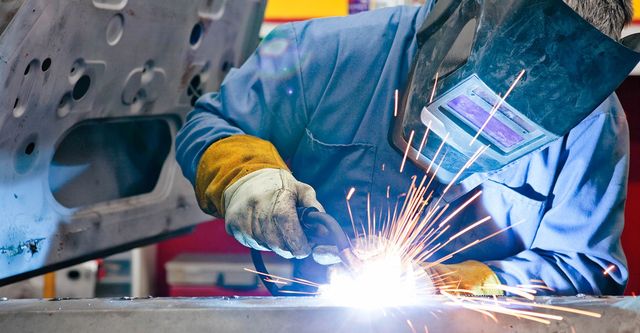Comprehending the Different Types of Welding Techniques and Solutions Available

Introduction of Welding Techniques
Welding strategies include a varied series of techniques made use of to join materials with each other completely. One common approach is arc welding, which includes creating an electric arc between the base and an electrode product to melt and fuse them with each other. This strategy is functional and can be used with various metals, making it one of one of the most widely utilized welding processes.

In addition, TIG welding, or Gas Tungsten Arc Welding (GTAW), is a accurate and tidy welding method that makes use of a non-consumable tungsten electrode to develop the weld. TIG welding is commonly made use of for thinner materials and offers superb control over the welding process. On the whole, recognizing these numerous welding strategies is crucial for picking the most ideal approach for various tasks.
Commonly Utilized Welding Methods
A range of frequently used methods are employed in the field of welding to efficiently join materials with each other. Among the most extensively made use of techniques is Gas Steel Arc Welding (GMAW), additionally known as MIG welding. This approach uses a cord electrode that is fed with a welding gun, in addition to a protecting gas to secure the weld from impurities in the air. Another typical technique is Protected Steel Arc Welding (SMAW), or stick welding, which uses a flux-coated electrode to produce the weld. Tungsten Inert Gas (TIG) welding is preferred for its precision and versatility, making use of a non-consumable tungsten electrode to create the weld. Flux-Cored Arc Welding (FCAW) is typically utilized in commercial settings because of its high welding rate and transportability. Furthermore, Immersed Arc Welding (SAW) is excellent for creating deep welds on thick products. These typically utilized welding approaches satisfy various needs and products, supplying choices for various welding applications.
Advanced Welding Services
Building upon the structure of frequently utilized welding methods, the world of sophisticated welding solutions incorporates cutting-edge techniques and innovations that press the borders of precision and effectiveness in material signing up with procedures. Advanced welding services usually entail specialized techniques such as laser welding, electron light beam welding, and rubbing mix welding. Laser welding uses an extremely focused light beam of light to specifically join steels with marginal heat-affected areas, making it suitable for complex or fragile parts. Electron beam welding, on the other hand, utilizes a high-velocity electron light beam to create deep weld penetrations in products like aerospace alloys or different steels. Rubbing stir welding, a solid-state joining procedure, makes it possible for the welding of materials that are challenging to fuse utilizing typical approaches, like aluminum and copper. These sophisticated techniques use enhanced control over the welding procedure, causing stronger, more durable welds with minimized distortion and improved overall top quality.
Specialized Welding Techniques

An additional specialized welding method is laser beam of light welding, where an extremely focused beam is utilized to sign up with steels with very little heat-affected areas and distortion. This technique is generally used in sectors needing high accuracy and cleanliness, such as electronics and clinical tool manufacturing. In addition, explosive welding is a distinct method that makes use of controlled dynamites Recommended Site to bond different metals together, creating solid and reliable joints. These specialized welding techniques showcase the diversity and advancement existing in the area of welding, supplying solutions for a large range of industrial applications.

Selecting the Right Welding Process
With various welding methods available, it is crucial to take into consideration aspects such as the type of steel, density, joint style, and preferred end result when picking the ideal welding procedure. Among the typical welding methods are Gas Steel Arc Welding (GMAW), Secured Metal Arc Welding (SMAW), Gas Tungsten Arc Welding (GTAW), and Flux-Cored Arc Welding (FCAW) GMAW, additionally understood as MIG welding, is suitable for welding slim to thick steels and is flexible in numerous placements.
Conclusion
Finally, understanding the numerous types of welding techniques and solutions available is necessary for selecting the right technique for a particular task. By recognizing the commonly utilized welding approaches, progressed welding services, and specialized techniques, individuals can make enlightened choices to blog make certain the success of their welding jobs. It is very important to take into consideration variables such as products, job requirements, and spending plan when selecting the most suitable welding procedure.
From traditional approaches like stick welding to cutting-edge procedures such as laser welding, the globe of welding offers a wide range of alternatives for signing up with metals with each other.Furthermore, TIG welding, or Gas Tungsten Arc Welding (GTAW), is a precise and tidy welding technique that uses a non-consumable tungsten electrode to produce the weld. Advanced welding solutions often entail specialized approaches such as laser welding, electron beam welding, and rubbing mix welding. Among the usual welding approaches are Gas Metal Arc Welding (GMAW), Secured Metal Arc Welding (SMAW), Gas Tungsten Arc Welding (GTAW), and Flux-Cored Arc Welding (FCAW) By being mindful of the frequently visit this website made use of welding approaches, advanced welding solutions, and specialized strategies, individuals can make educated choices to make sure the success of their welding projects.